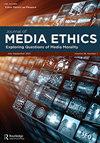Audience Comments and the Civic Space that Rarely Was
IF 0.9
3区 哲学
Q3 COMMUNICATION
引用次数: 2
Abstract
As more and more news organizations shutter their comment sections, it is worth considering what they mean (or, rather, meant) to journalism and to journalists. How do we explain their demise and is this a loss worth mourning? If there is a resounding theme throughout the ample academic literature about journalists’ attitudes to comments it is that journalists never quite adopted them into their working routines. In such literature, journalists were frequently cast as the enemies of progress, whether as technological luddites unable to get to grips with emergent technologies or as turf-protecting zealots resentful of the eroding boundaries of their field. It would seem that these obstinate traditionalists simply did not grasp the ideals of the Internet as “the democratic space upon which citizens and journalists interact more porous, pluralistic, and directly representative” (Papacharissi, 2009, p. viii). Scholars, naturally, did. This utopian view of comments, and the wider digital infrastructure they represented, always seemed to me to be curiously out of step with what I was seeing in, and hearing about, actual comment sections. With academic journal article after academic journal article extolling the virtues of comment sections as spaces for citizen deliberation and press criticism, I must admit to some envy at the comment sections that the authors of these scholarly works must have been coming across. Quite unlike the comment sections I was encountering, and hearing journalists complain about, in article after article, in publication after publication. What good fortune, indeed! In what I view as a seminal review of the research about audience participation in the digital journalism literature, Peters and Witschge (2015) note a shift away from a more-or-less traditional emphasis on the duty of journalists to provide the means for citizens to participate in democracy (what they call participation through news) to an emergent duty of journalists to provide the means for citizens to participate in the journalistic process (what they call participation in news). This is an eloquent way of articulating something that is, at its core, quite troubling. How, then, do we explain journalistic resistance to comment sections? Here, I offer an analogy. Assessing the dominance of the objectivity norm in U.S. journalism, Michael Schudson (2001) notes that “explaining the articulation of a norm is part of explaining the norm” (p. 150). Rejecting economically and technologically deterministic explanations for objectivity’s emergence and hegemony, Schudson notes that objectivity has persisted – for better or for worse – because it is cloaked in a moral discourse that directs action. In other words, journalists rationalize their routines and behaviors if they view them as servicing a larger mission. It is, by now, something of a truism that the disintegration of U.S. journalism’s economic model means that journalists are perennially trying to do more with less. As I consider these harassed, overworked journalists being tasked with managing comment sections awash with misinformation (Hinnant, Subramanian, & Young, 2016), xenophobia (Antony & Thomas, 2017), and hate speech (Wilhelm & Joeckel, 2019), is it any wonder that they responded so unenthusiastically? Why would we expect them to delight in laboring in service of a working routine so profoundly unmoored from how they view their democratic role?观众评论和很少存在的公民空间
随着越来越多的新闻机构关闭他们的评论区,有必要考虑一下,这对新闻业和记者意味着什么(或者更确切地说,意味着什么)。我们如何解释他们的死亡,这是一个值得哀悼的损失吗?在大量关于记者对评论态度的学术文献中,如果有一个响亮的主题,那就是记者从未将评论完全纳入他们的工作日常。在这类文献中,记者经常被描绘成进步的敌人,要么是无法掌握新兴技术的技术勒德分子,要么是对自己领域边界侵蚀感到不满的保护地盘的狂热分子。这些顽固的传统主义者似乎根本没有把握互联网的理想,即“公民和记者互动的民主空间更加渗透,多元化和直接代表性”(Papacharissi, 2009, p. viii)。学者们自然做到了。这种乌托邦式的评论,以及它们所代表的更广泛的数字基础设施,在我看来总是与我在实际评论区所看到和听到的奇怪地不一致。随着一篇又一篇学术期刊文章赞美评论区作为公民审议和媒体批评空间的优点,我必须承认,对这些学术作品的作者所遇到的评论区有些羡慕。与我在一篇又一篇文章、一篇又一篇出版物中遇到的评论区和听到的记者们的抱怨完全不同。真是好运气啊!在我看来,这是对数字新闻文献中受众参与研究的一次开创性回顾,Peters和Witschge(2015)注意到,传统上或多或少强调记者为公民参与民主提供手段的责任(他们称之为通过新闻参与)转变为记者为公民参与新闻过程提供手段的紧急责任(他们称之为新闻参与)。这是一种雄辩的表达方式,它的核心是相当令人不安的。那么,我们该如何解释媒体对评论区的抵制呢?在这里,我打个比方。Michael Schudson(2001)在评估客观性规范在美国新闻业的主导地位时指出,“解释规范的表达是解释规范的一部分”(第150页)。Schudson拒绝对客观性的出现和霸权进行经济和技术上的决定论解释,他指出,客观性一直存在——无论是好是坏——因为它被一种指导行动的道德话语所掩盖。换句话说,如果记者认为他们是在为更大的使命服务,他们就会把自己的日常工作和行为合理化。到目前为止,美国新闻业经济模式的瓦解意味着记者们总是试图用更少的钱做更多的事,这是一个不言而喻的事实。当我想到这些受到骚扰、工作过度的记者被要求管理充斥着错误信息(Hinnant, Subramanian, & Young, 2016)、仇外心理(Antony & Thomas, 2017)和仇恨言论(Wilhelm & Joeckel, 2019)的评论区时,他们的反应如此冷淡,这有什么奇怪的吗?为什么我们会期望他们乐于为一种与他们对自己的民主角色的看法如此大相径庭的日常工作服务呢?
本文章由计算机程序翻译,如有差异,请以英文原文为准。
求助全文
约1分钟内获得全文
求助全文

 求助内容:
求助内容: 应助结果提醒方式:
应助结果提醒方式:


